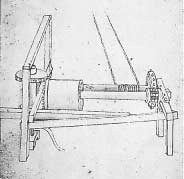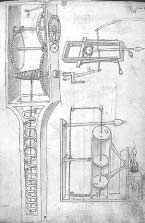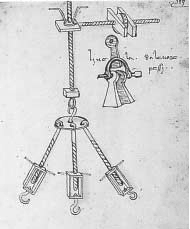Brunelleschis Dome (10 page)
Read Brunelleschis Dome Online
Authors: Ross King

When one of the two pinions on the vertical shaft was in mesh with the cogs on the horizontal shaft, the gear train was set in motion. The large rope drum was attached to a medium-sized horizontal spindle, the
sùbbio mezzano
, which, through a secondary set of gearing at its opposite end, engaged another shaft, the
sùbbio minore
, a smaller horizontal spindle running parallel with the two other rope drums. Any of these three horizontal shafts — small, medium, or large — could be used to raise or lower loads. Because of their varying diameters, however, each turned the rope at a different rate of speed and required a different degree of effort from the oxen. The
sùbbio grosso
, five feet in diameter, raised the load more quickly than the
sùbbio minore
, which was only 20 inches in diameter and therefore forced the oxen to make many more revolutions for each ascent. This smallest shaft was used to raise the heaviest loads, much in the same way that a cyclist uses the smallest chain wheel to engage the bicycle chain on steep ascents. Using this shaft, one ox could raise a load of 1,000 pounds to an elevation of 200 feet in approximately thirteen minutes.
3

A detail of the ox-hoist that shows, on the right-hand side, the secondary set of gearing.
Once inaugurated in the summer of 1421, the giant hoist must have been a marvel even in Florence, where the building boom of the previous fifty years meant the populace was accustomed to seeing machines raising skyward heavy loads of brick and stone. After being transported in a cart from the quarry to the building site, a sandstone beam weighing almost two tons would be slid into the octagon on elder-wood rollers that had been greased with tallow or soap. It was then attached to the hoist rope by means of a special hanger, the sort of mortise-and-tenon contrivance now known as a lewis bolt. This hanger was yet another of Filippo’s innovations, probably inspired by his study of Roman masonry. It required a rectangular hole a foot long to be cut into the top of the stone, then undercut several degrees such that it was dovetailed, narrowest on the surface and widest at the bottom. Next, the three iron bars comprising the hanger were inserted into the hole. The outside two were dovetailed in order to fit the mortise, while the middle one was flat. The outside bars were inserted first and then prevented from slipping out of the socket by the middle one, which would have been hammered into place, providing a tight fit. Finally, a crossbolt was slid horizontally through the eyes in the top of the three bars and the rope attached to it. The stone was then ready to be winched onto the cupola.
Certain perils were inherent in the operation of the ox-hoist. Friction had to be minimized because the energy lost in friction created heat, which could easily start a fire, an obvious catastrophe if the beam was dangling in midair. And Filippo’s enormous rope, with its cross section of some two and a half inches, would have been in danger of combustion, for thick ropes with a great resistance to bending generate a lot of friction. Smooth walnut tubes were therefore used to encase the drums, and the rope was wetted with water in order to prevent it catching fire as it passed through the pulley wheels. Sea water, vinegar, or spoiled wine were preferable to fresh water, which rotted the rope.
Once the load reached the working level, a signal was shouted from the cupola, and the oxen were halted. The rope was detached from the crossbolt, and far below, the clutch screw was turned, changing the gear. The oxen trudged forward again, unspooling the rope from the drum, which now rotated in the opposite direction, bringing the rope back down to the floor of the octagon, where it would be attached to another lewis bolt that in the meantime had been secured to the next sandstone beam. The whole operation would then begin all over again. It must have run like clockwork, for the hoist raised, on average, fifty loads per day, or roughly one every ten minutes.
4

A drawing of a spring-driven clock, possibly based on one of Brunelleschi’s designs.
The exact inspiration for this remarkable machine remains as mysterious as that behind Filippo’s other inventions. The specialist theoretical knowledge needed for constructing such a hoist was largely unavailable in 1420, though soon afterward a number of manuscripts on Greek mechanics and mathematics began arriving in Florence, putting architects and inventors of the Renaissance in possession of engineering techniques far beyond those available in the Middle Ages. In 1423, two years after Filippo finished building his hoist, a Sicilian adventurer named Giovanni Aurispa returned from Constantinople with a hoard of 238 manuscripts written in Greek, a language that scholars in Italy had learned only in the previous few decades. Among these treasures were six lost plays by Aeschylus and seven by Sophocles, as well as works by Plutarch, Lucian, Strabo, and Demosthenes. But there was also a complete copy of the works of the geometer Proclus of Alexandria and, even more important for engineers, a treatise on ancient lifting devices, the
Mathematical Collection
of Pappus of Alexandria. This latter work, from the fourth century
A.D.
, describes the windlass, the compound pulley, the worm and wheel, the screw and the gear train — all essential features of hoists and cranes. In the decades that followed, so many manuscripts on Greek mathematics and engineering emerged that it is possible to speak of a “renaissance of mathematics” in fifteenth-century Italy.
5
All of these discoveries came too late to help Filippo with his ox-hoist. In any case the
capomaestro
, like Shakespeare, knew little Latin and less Greek, so these manuscripts would have been of slender value to him unless they were first translated into Italian.
*
Filippo therefore probably knew about the workings of pulleys, clutches, and gear trains not through old parchments but rather from his own experience. Growing up only several hundred yards from the cathedral, he saw in almost daily operation what Manetti calls “a variety and multitude of different devices”: treadmills and cranes built under the direction of previous
capomaestri
, including Giovanni di Lapo Ghini, who in the 1350s devised a treadwheel for winching masonry to the vaults of the nave. Still, however much they may have stimulated Filippo’s youthful imagination, these machines would have been unsophisticated in comparison to the ox-hoist, consisting simply of shafts and wheels that moved a rope over a system of pulleys. It is unlikely in the extreme, for instance, that any of them included complex meshing parts such as those featured in his own hoist, let alone prototypes of the motion-reversing clutch.
Manetti also suggests another inspiration for the ox-hoist. He claims that Filippo, while still a young goldsmith, built a number of mechanical clocks equipped with “various and diverse generations of springs.” If this story is true, these devices would have been as far ahead of their time as the ox-hoist. All mechanical clocks during this period were driven by a falling weight attached to a cord spooled around a drum. As the weight descended, it unwound the cord and turned the drum, which then rotated a wheel whose teeth — like those on the wheel of the ox-hoist’s
sùbbio grosso
— engaged the pinions and gears of the drivetrain, the motions of which were regulated by an escapement. But Filippo’s clocks, according to Manetti, used springs instead of weights to drive their gear trains — an astonishing claim, since spring-loaded clocks are not known to have been invented for almost another hundred years. Indeed, elastic springs of the sort needed for such clocks were not developed until many decades later, when metallurgical techniques were refined enough that it became possible to manufacture resilient wire.

Apart from Manetti’s claim, no evidence exists for these spring-driven clocks other than an anonymous sketch done later in the century, possibly based on a design by Filippo’s friend Mariano Taccola, who is known to have drawn a number of the
capomaestro’
s inventions. It is plausible, however, that Filippo’s experimentations with clock mechanisms, with cogwheels and counterweights, served him when the time came to design his ox-hoist.
6
Whatever its inspiration, the hoist inspired great confidence from the start. As soon as it was finished, Filippo pressed the Opera for a prize, mindful that no one had so far received the 200 florins promised in the 1418 proclamation. Within a month a substantial award of 100 florins was granted to him “for his ingeniousness and labors in connection with the device newly invented by him for hoisting.” In what now seems like a classic understatement, the Opera commended him for the design of this hoist,“which is more useful than the one previously employed.”
The ox-hoist had been designed to raise heavy loads far into the air with maximum speed and efficiency. In this task it probably excelled any hoist ever constructed, for one or two oxen were able to raise loads that before had taken as many as six pairs. But this remarkable machine nonetheless shared the shortcoming of all hoists: devised only to raise or lower burdens, it was unable to move them laterally. Yet sideways motion was an obvious requirement for laying the beams for the stone chains. These beams were interlocking and, at several levels, radially tilted toward the vertical axis of the dome. A machine capable of shifting them infinitesimal distances in any direction — up, down, or sideways — was therefore required so they could be laid in place with pinpoint accuracy.
Since 1413 a crane known as the
stella
had been used for the vaulting of the tribunes. But ten years later this machine, like the
rota magna
, was no longer adequate for the greater demands of the cupola. A more powerful crane with a longer working arm was needed. And the Opera del Duomo met this challenge in typical fashion: it proclaimed yet another competition, asking for designs to be submitted by April 1423.
The winter of 1422-23 proved to be a hard one. The
tramontana,
a raw wind that, according to folklore, brought depression and fatigue to Florence, howled down from the Apennines. In January work on the cupola stopped because of the cold, and a network of boards had to be placed over the walls to protect them from snow. Filippo took advantage of this hiatus to devise a crane for the competition. Given the success of the ox-hoist, the result of the Opera’s deliberations could have surprised no one: in April the wardens selected his design over one submitted by a rival, Antonio da Vercelli, whom Vasari implies was a creature that Lorenzo Ghiberti thrust forward in the hope of challenging Filippo’s expertise and thwarting his authority.
Within a few days the wood for Filippo’s machine began arriving at the building site: eight pine beams, along with two elm trunks, each 15 feet long. Then a walnut tree was delivered, from which the crane’s screws would be carved. As with the ox-hoist, the machine was built in a remarkably short time, less than three months, and was ready by the beginning of July.
Known as the
castello
, this new crane consisted of a wooden mast surmounted by a pivoted horizontal beam. Sitting high on the cupola, it must have resembled a gallows. The horizontal crossbeam was furnished with screws, slideways, and a counterweight. One of the horizontal screws moved the counterweight along the slideway, while the other manipulated the load, which could also be raised or lowered by means of a turnbuckle. This turnbuckle permitted the installation of the stone with far greater control than the ox-hoist, whose driver, several hundred feet below, relied on shouted commands from the cupola.
